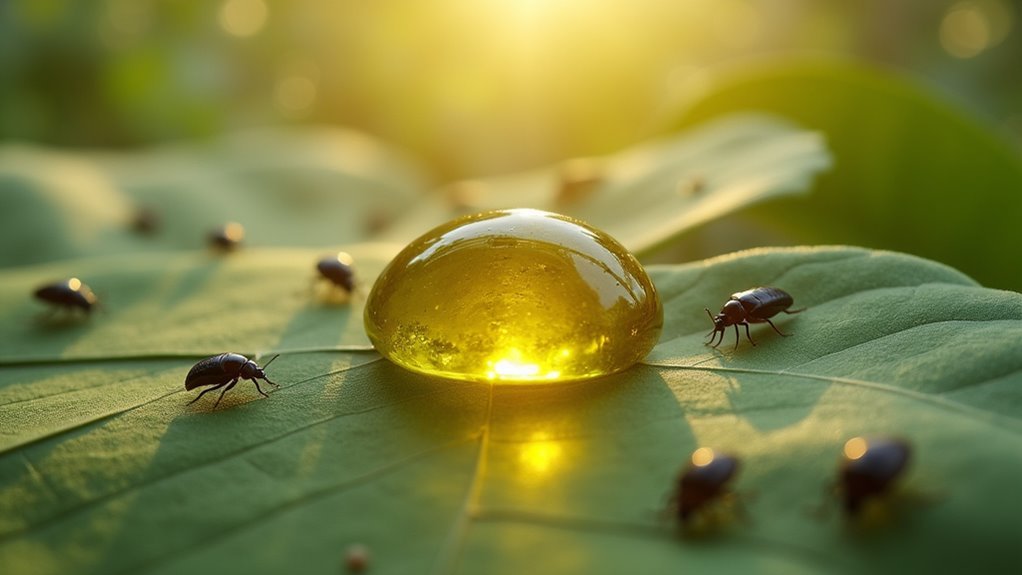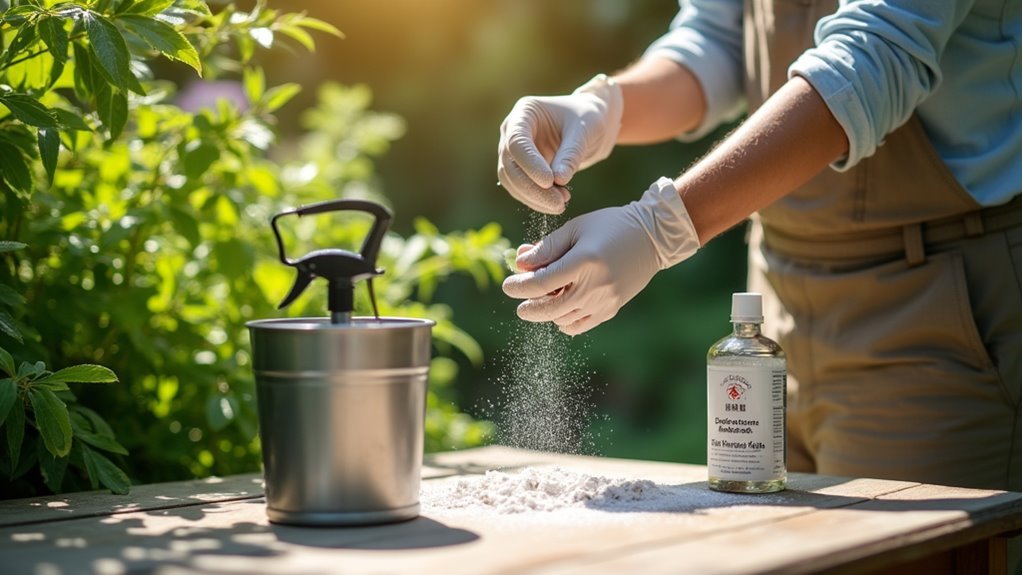Neem oil’s effectiveness against bed bugs comes from its active compounds, particularly azadirachtin, which acts as an insect growth regulator that disrupts their molting process and prevents maturation. You’ll also benefit from nimbin and nimbidin, which target bed bugs’ nervous systems and create repellent effects. These compounds interfere with feeding behavior, cause starvation, and reduce female fertility rates. Results typically appear within 24-48 hours, though you’ll discover that proper application techniques considerably amplify these natural pest control benefits.
Understanding Neem Oil’s Active Compounds and Properties

While many commercial pesticides rely on synthetic chemicals, neem oil harnesses the power of naturally occurring compounds that have evolved specifically to combat insects.
You’ll find azadirachtin as neem oil’s primary weapon—an insect growth regulator that disrupts bed bugs’ molting process and prevents them from reaching adulthood.
The active compounds nimbin and nimbidin enhance its insecticidal properties by targeting bed bugs’ nervous systems and interfering with their feeding behavior.
These compounds don’t just kill; they also provide repellent properties that keep bed bugs away from treated areas.
Neem oil’s dual-action formula eliminates existing bed bug infestations while creating protective barriers that prevent future invasions.
When you apply neem oil directly, you’ll see results within 24-48 hours, while its fertility-reducing effects guarantee long-term population control.
How Azadirachtin Disrupts Bed Bug Life Cycles
When azadirachtin enters a bed bug’s system, it immediately begins wreaking havoc on the insect’s natural development process. This compound acts as an insect growth regulator, preventing bed bugs from molting and advancing through their bed bug life cycle.
You’ll see fewer mature insects capable of reproduction as azadirachtin blocks their progression to adulthood.
The compound also disrupts feeding behavior by affecting their nervous system, causing bed bugs to starve. Female bed bugs experience reduced fertility rates, dramatically slowing population growth.
Within 24 to 48 hours of direct contact, bed bugs typically die from these combined effects.
This natural solution offers effective pest control by targeting multiple biological functions simultaneously, making it difficult for bed bugs to develop resistance.
Neem Oil’s Impact on Bed Bug Feeding and Reproduction

Beyond disrupting development, neem oil delivers a devastating blow to bed bugs’ most crucial survival functions. When you apply neem oil, its azadirachtin compound directly interferes with bed bugs’ feeding behavior, causing them to lose their appetite and eventually starve.
You’ll notice weakened individuals that can’t sustain themselves nutritionally.
The reproductive impact proves equally devastating. Neem oil considerably reduces female bed bugs’ fertility rates, meaning they’ll lay fewer eggs overall.
This reproductive disruption creates a cascading effect throughout their life cycle, as fewer offspring means reduced population growth. When you consistently apply neem oil treatments, you’re fundamentally breaking the breeding chain that allows infestations to flourish.
This dual assault on both feeding and reproduction makes neem oil particularly effective at controlling established bed bug populations.
Contact vs. Systemic Effects on Bed Bug Populations
Understanding how neem oil affects bed bugs requires distinguishing between its contact and systemic mechanisms of action.
When you apply neem oil directly, it creates immediate contact effects that disrupt feeding behaviors and kill bed bugs within 24-48 hours. The azadirachtin compound acts as an insect growth regulator, preventing molting and life stage progression through direct contact.
Direct neem oil application disrupts bed bug feeding and kills them within 24-48 hours through azadirachtin’s growth-regulating properties.
However, neem oil’s systemic effects are considerably weaker and short-lived. Without direct contact, its impact on bed bug populations diminishes rapidly, making thorough application essential.
You’ll notice reduced fertility rates in female bed bugs after direct exposure, but this effect won’t persist systemically. This means you’ll need frequent reapplications to maintain control over bed bug populations, emphasizing direct contact over systemic action.
Proper Application Methods for Maximum Effectiveness

To maximize neem oil’s effectiveness against bed bugs, you’ll need to get your mixing ratios right and understand where to apply the solution.
Proper dilution guarantees the oil spreads evenly and penetrates hiding spots, while targeting the right areas assures you’re hitting bed bugs where they actually live and breed.
You’ll also need to follow a consistent reapplication schedule since neem oil’s potency decreases over time.
Mixing Ratios and Dilution
When preparing neem oil for bedbug treatment, you’ll need to achieve the right concentration to guarantee both safety and effectiveness. The most common mixing ratios involve combining 2 fluid ounces of cold-pressed neem oil with 1 gallon of water and 2 fluid ounces of mild detergent.
This diluted neem oil creates proper emulsification for treating bed bug infestations across larger areas.
For targeted applications, you can use a more concentrated approach with 10 drops of neem oil per ounce of water. This effective natural solution works well for spot treatments on specific hiding spots.
Always add detergent to help the oil mix properly with water, as pure neem oil won’t dissolve effectively alone. Test your chosen concentration on a small fabric area first to prevent potential discoloration.
Target Areas and Coverage
Once you’ve prepared your neem oil solution at the proper concentration, focus your application efforts on bed bugs’ preferred hiding locations. These pests squeeze into tiny crevices due to their flat bodies, making thorough coverage essential for effective treatment.
| Target Areas | Application Focus | Coverage Priority |
|---|---|---|
| Mattress seams | All edges and corners | High |
| Bed frames | Joints and crevices | High |
| Baseboards | Wall-floor gaps | Medium |
You’ll need extensive coverage of furniture cracks, behind headboards, and inside nightstands. Don’t overlook carpet edges and curtain folds where bed bugs often hide. Apply your neem oil solution systematically, ensuring every potential harborage site receives treatment. Remember to conduct a patch test on fabrics before extensive application to prevent damage while achieving maximum effectiveness.
Reapplication Frequency Guidelines
Neem oil’s pesticidal properties diminish within a week, making regular reapplication essential for sustained bed bug control.
You’ll need to reapply every 7 days or sooner if bed bugs persist, as consistent treatment disrupts their feeding and reproductive cycles more effectively.
Follow these reapplication guidelines for maximum effectiveness:
- Monitor activity levels – Heavy infestations require more frequent treatments than lighter ones.
- Reapply after cleaning – Vacuuming or washing treated areas removes the neem oil solution.
- Maintain thorough coverage – Target all hiding spots including mattress seams, furniture cracks, and bed frames during each application.
Mix neem oil with mild detergent to improve surface adherence.
You’ll achieve better results by adjusting your reapplication frequency based on ongoing bed bug activity rather than following a rigid schedule.
Limitations and Realistic Expectations for Neem Oil Treatment
Although neem oil offers a natural approach to bed bug control, it’s essential you understand its limitations before relying on it as your primary treatment method.
While neem oil can disrupt bed bugs’ reproductive cycles, it won’t eliminate every stage of your bed bug infestation. The treatment’s effectiveness depends heavily on direct contact, yet bed bugs hide in hard-to-reach areas, making complete coverage nearly impossible.
You’ll need realistic expectations about neem oil’s short-term effects, which typically last only one week. For severe infestations, neem oil alone often proves insufficient.
Consider integrating it with other pest control methods or professional services. Natural remedies like neem oil work best as part of thorough pest management strategies rather than standalone solutions for complete eradication.
Combining Neem Oil With Other Natural Pest Control Strategies
You’ll maximize neem oil’s effectiveness against bed bugs by combining it with other natural pest control methods rather than relying on it alone.
Essential oil combinations can create powerful synergistic effects, while heat treatment integration provides a thorough approach that attacks bed bugs from multiple angles.
These strategic combinations address the limitations of using neem oil as a standalone solution and greatly improve your chances of eliminating infestations.
Essential Oil Combinations
Several natural pest control methods work synergistically with neem oil to create more powerful bedbug treatments than any single approach alone.
You can combine neem oil with essential oils like lavender, tea tree, or peppermint to greatly boost your pest control arsenal. These essential oils complement neem oil’s insecticidal properties while adding their own abilities to repel bed bugs.
Here are three powerful essential oil combinations to enhance your neem oil treatment:
- Neem oil + lavender oil – Creates a calming scent while disrupting bed bug feeding
- Neem oil + tea tree oil – Combines antimicrobial properties with pest deterrence
- Neem oil + peppermint oil – Masks attractant scents while providing broader repellent effects
These natural treatments target multiple aspects of bed bug behavior, increasing your chances of complete elimination.
Heat Treatment Integration
When you combine heat treatment with neem oil applications, you create a dual-action strategy that targets bed bugs through both immediate elimination and long-term prevention.
Heat treatment kills all life stages of bed bugs within a day, including hidden ones that neem oil can’t reach directly. This guarantees thorough eradication of your infestation.
Neem oil enhances the heat treatment’s effectiveness by disrupting reproductive cycles and feeding behaviors. Its residual properties deter any surviving bed bugs after heat application, providing ongoing pest control protection.
The combination addresses both immediate needs through heat and long-term prevention through neem’s insect growth-regulating properties.
You’ll want to monitor treated areas regularly for reinfestation signs.
This dual approach maximizes your success rate and prevents future outbreaks more effectively than using either method alone.
Frequently Asked Questions
How Does Neem Oil Kill Bed Bugs?
You’ll find neem oil kills bed bugs through direct contact within 24-48 hours. It disrupts their nervous system, prevents molting with azadirachtin, reduces fertility, and makes feeding difficult, effectively eliminating infestations.
How Long Does Neem Oil Take to Work on Bugs?
You’ll see neem oil take effect on bugs within 24 to 48 hours of direct contact. However, you’ll need to reapply it weekly since its effectiveness only lasts about one week.
What Are the Downsides of Neem Oil?
You’ll face several challenges with neem oil: it only works through direct contact, requires weekly reapplication, may cause skin irritation, and won’t prevent reinfestation once effects fade completely.
What Happens if You Leave Neem Oil on Overnight?
If you leave neem oil on overnight, you’ll enhance its effectiveness against bed bugs. The extended exposure increases mortality rates, disrupts molting processes, and creates a lasting repellent effect that deters bugs from returning.
In Summary
You’ll find neem oil’s effectiveness against bedbugs stems from azadirachtin’s ability to disrupt their hormonal systems and feeding behaviors. While it won’t eliminate severe infestations overnight, you can use it as part of an integrated approach for better results. Remember that consistency in application matters most, and you shouldn’t expect miracle cures. Combine neem oil with thorough cleaning, heat treatment, and other natural methods for your best chance at controlling these persistent pests effectively.





Leave a Reply